Evidence-Based Practice Guideline of NGC in Sepsis Management
VerifiedAdded on 2022/12/26
|11
|2679
|98
AI Summary
This document provides an analysis of the National Guideline Clearinghouse database related to sepsis management. It discusses the methodology and science behind evidence-based practice guidelines and evaluates the guidelines provided by NGC for sepsis management. The document also examines the funding, development strategy, and applicability of the guidelines, as well as their relevance and practicality in clinical practice.
Contribute Materials
Your contribution can guide someone’s learning journey. Share your
documents today.
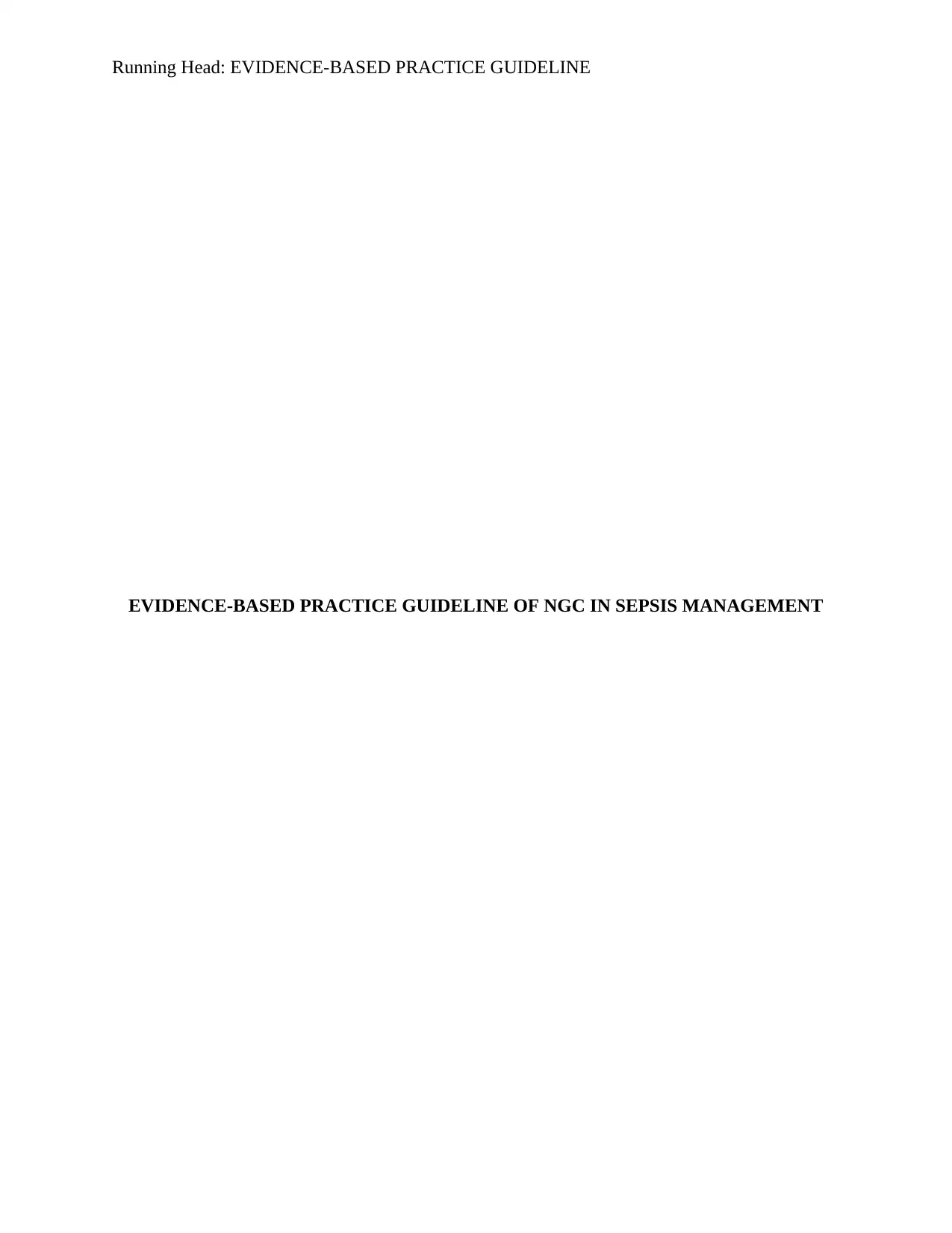
Running Head: EVIDENCE-BASED PRACTICE GUIDELINE
EVIDENCE-BASED PRACTICE GUIDELINE OF NGC IN SEPSIS MANAGEMENT
EVIDENCE-BASED PRACTICE GUIDELINE OF NGC IN SEPSIS MANAGEMENT
Secure Best Marks with AI Grader
Need help grading? Try our AI Grader for instant feedback on your assignments.
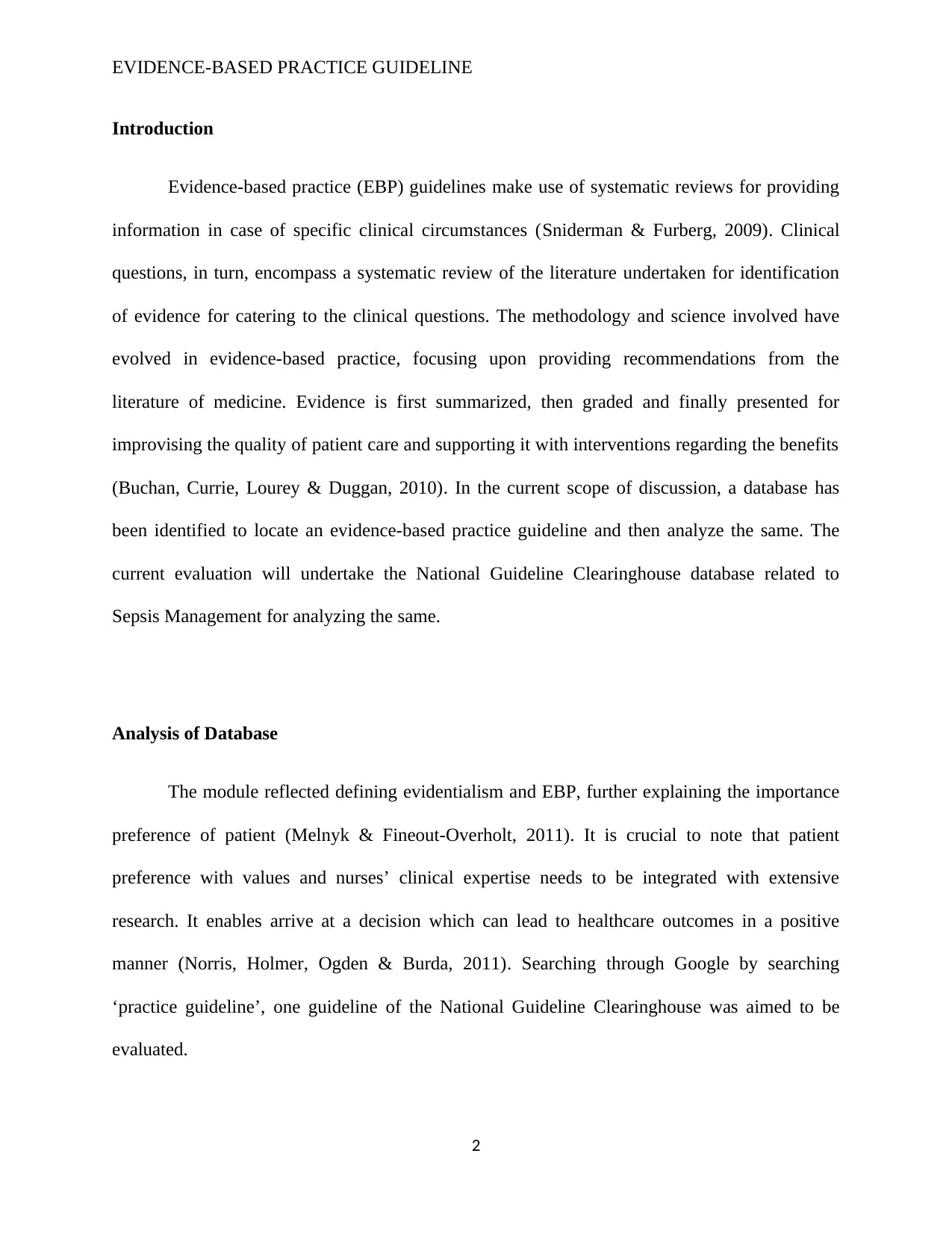
EVIDENCE-BASED PRACTICE GUIDELINE
Introduction
Evidence-based practice (EBP) guidelines make use of systematic reviews for providing
information in case of specific clinical circumstances (Sniderman & Furberg, 2009). Clinical
questions, in turn, encompass a systematic review of the literature undertaken for identification
of evidence for catering to the clinical questions. The methodology and science involved have
evolved in evidence-based practice, focusing upon providing recommendations from the
literature of medicine. Evidence is first summarized, then graded and finally presented for
improvising the quality of patient care and supporting it with interventions regarding the benefits
(Buchan, Currie, Lourey & Duggan, 2010). In the current scope of discussion, a database has
been identified to locate an evidence-based practice guideline and then analyze the same. The
current evaluation will undertake the National Guideline Clearinghouse database related to
Sepsis Management for analyzing the same.
Analysis of Database
The module reflected defining evidentialism and EBP, further explaining the importance
preference of patient (Melnyk & Fineout-Overholt, 2011). It is crucial to note that patient
preference with values and nurses’ clinical expertise needs to be integrated with extensive
research. It enables arrive at a decision which can lead to healthcare outcomes in a positive
manner (Norris, Holmer, Ogden & Burda, 2011). Searching through Google by searching
‘practice guideline’, one guideline of the National Guideline Clearinghouse was aimed to be
evaluated.
2
Introduction
Evidence-based practice (EBP) guidelines make use of systematic reviews for providing
information in case of specific clinical circumstances (Sniderman & Furberg, 2009). Clinical
questions, in turn, encompass a systematic review of the literature undertaken for identification
of evidence for catering to the clinical questions. The methodology and science involved have
evolved in evidence-based practice, focusing upon providing recommendations from the
literature of medicine. Evidence is first summarized, then graded and finally presented for
improvising the quality of patient care and supporting it with interventions regarding the benefits
(Buchan, Currie, Lourey & Duggan, 2010). In the current scope of discussion, a database has
been identified to locate an evidence-based practice guideline and then analyze the same. The
current evaluation will undertake the National Guideline Clearinghouse database related to
Sepsis Management for analyzing the same.
Analysis of Database
The module reflected defining evidentialism and EBP, further explaining the importance
preference of patient (Melnyk & Fineout-Overholt, 2011). It is crucial to note that patient
preference with values and nurses’ clinical expertise needs to be integrated with extensive
research. It enables arrive at a decision which can lead to healthcare outcomes in a positive
manner (Norris, Holmer, Ogden & Burda, 2011). Searching through Google by searching
‘practice guideline’, one guideline of the National Guideline Clearinghouse was aimed to be
evaluated.
2
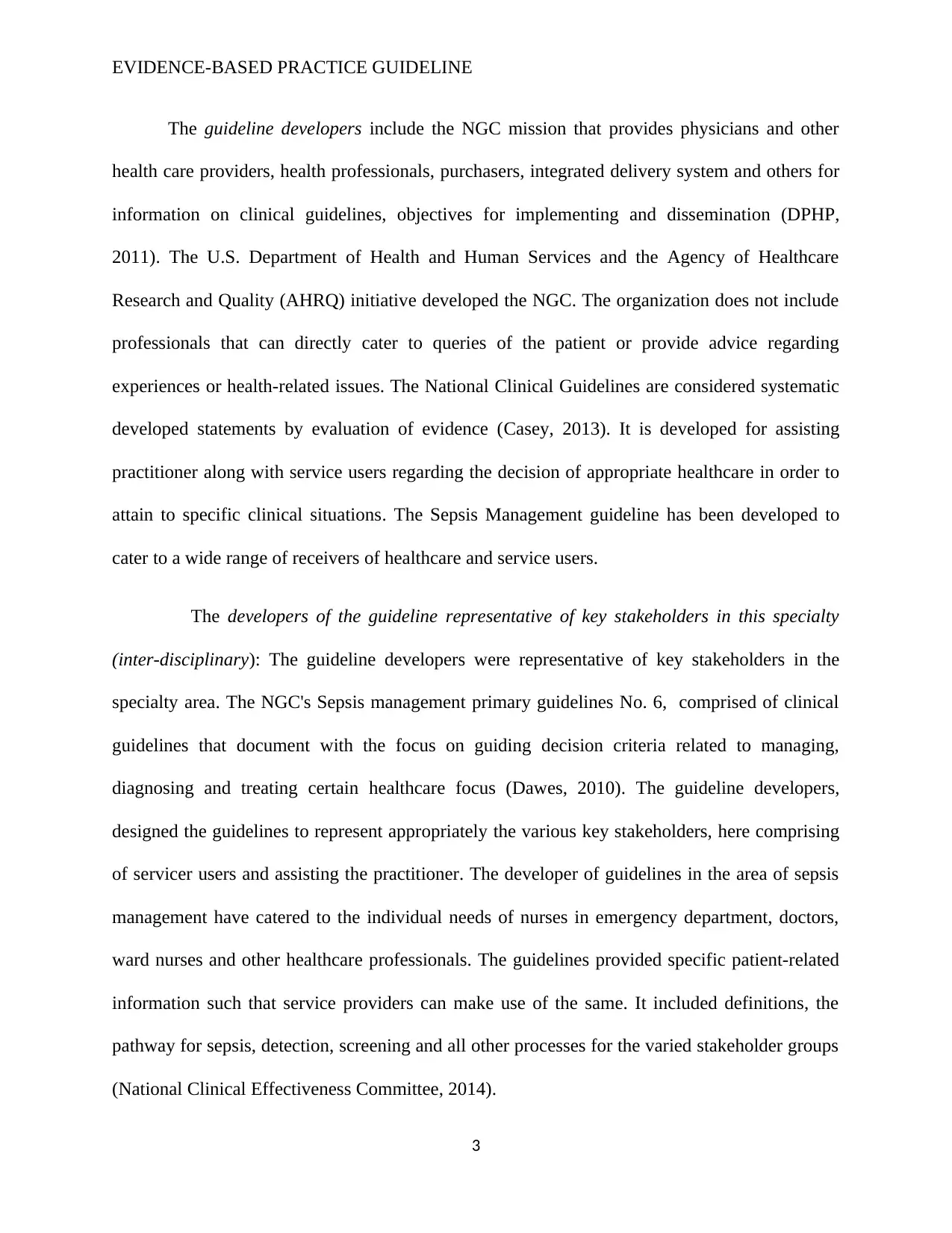
EVIDENCE-BASED PRACTICE GUIDELINE
The guideline developers include the NGC mission that provides physicians and other
health care providers, health professionals, purchasers, integrated delivery system and others for
information on clinical guidelines, objectives for implementing and dissemination (DPHP,
2011). The U.S. Department of Health and Human Services and the Agency of Healthcare
Research and Quality (AHRQ) initiative developed the NGC. The organization does not include
professionals that can directly cater to queries of the patient or provide advice regarding
experiences or health-related issues. The National Clinical Guidelines are considered systematic
developed statements by evaluation of evidence (Casey, 2013). It is developed for assisting
practitioner along with service users regarding the decision of appropriate healthcare in order to
attain to specific clinical situations. The Sepsis Management guideline has been developed to
cater to a wide range of receivers of healthcare and service users.
The developers of the guideline representative of key stakeholders in this specialty
(inter-disciplinary): The guideline developers were representative of key stakeholders in the
specialty area. The NGC's Sepsis management primary guidelines No. 6, comprised of clinical
guidelines that document with the focus on guiding decision criteria related to managing,
diagnosing and treating certain healthcare focus (Dawes, 2010). The guideline developers,
designed the guidelines to represent appropriately the various key stakeholders, here comprising
of servicer users and assisting the practitioner. The developer of guidelines in the area of sepsis
management have catered to the individual needs of nurses in emergency department, doctors,
ward nurses and other healthcare professionals. The guidelines provided specific patient-related
information such that service providers can make use of the same. It included definitions, the
pathway for sepsis, detection, screening and all other processes for the varied stakeholder groups
(National Clinical Effectiveness Committee, 2014).
3
The guideline developers include the NGC mission that provides physicians and other
health care providers, health professionals, purchasers, integrated delivery system and others for
information on clinical guidelines, objectives for implementing and dissemination (DPHP,
2011). The U.S. Department of Health and Human Services and the Agency of Healthcare
Research and Quality (AHRQ) initiative developed the NGC. The organization does not include
professionals that can directly cater to queries of the patient or provide advice regarding
experiences or health-related issues. The National Clinical Guidelines are considered systematic
developed statements by evaluation of evidence (Casey, 2013). It is developed for assisting
practitioner along with service users regarding the decision of appropriate healthcare in order to
attain to specific clinical situations. The Sepsis Management guideline has been developed to
cater to a wide range of receivers of healthcare and service users.
The developers of the guideline representative of key stakeholders in this specialty
(inter-disciplinary): The guideline developers were representative of key stakeholders in the
specialty area. The NGC's Sepsis management primary guidelines No. 6, comprised of clinical
guidelines that document with the focus on guiding decision criteria related to managing,
diagnosing and treating certain healthcare focus (Dawes, 2010). The guideline developers,
designed the guidelines to represent appropriately the various key stakeholders, here comprising
of servicer users and assisting the practitioner. The developer of guidelines in the area of sepsis
management have catered to the individual needs of nurses in emergency department, doctors,
ward nurses and other healthcare professionals. The guidelines provided specific patient-related
information such that service providers can make use of the same. It included definitions, the
pathway for sepsis, detection, screening and all other processes for the varied stakeholder groups
(National Clinical Effectiveness Committee, 2014).
3
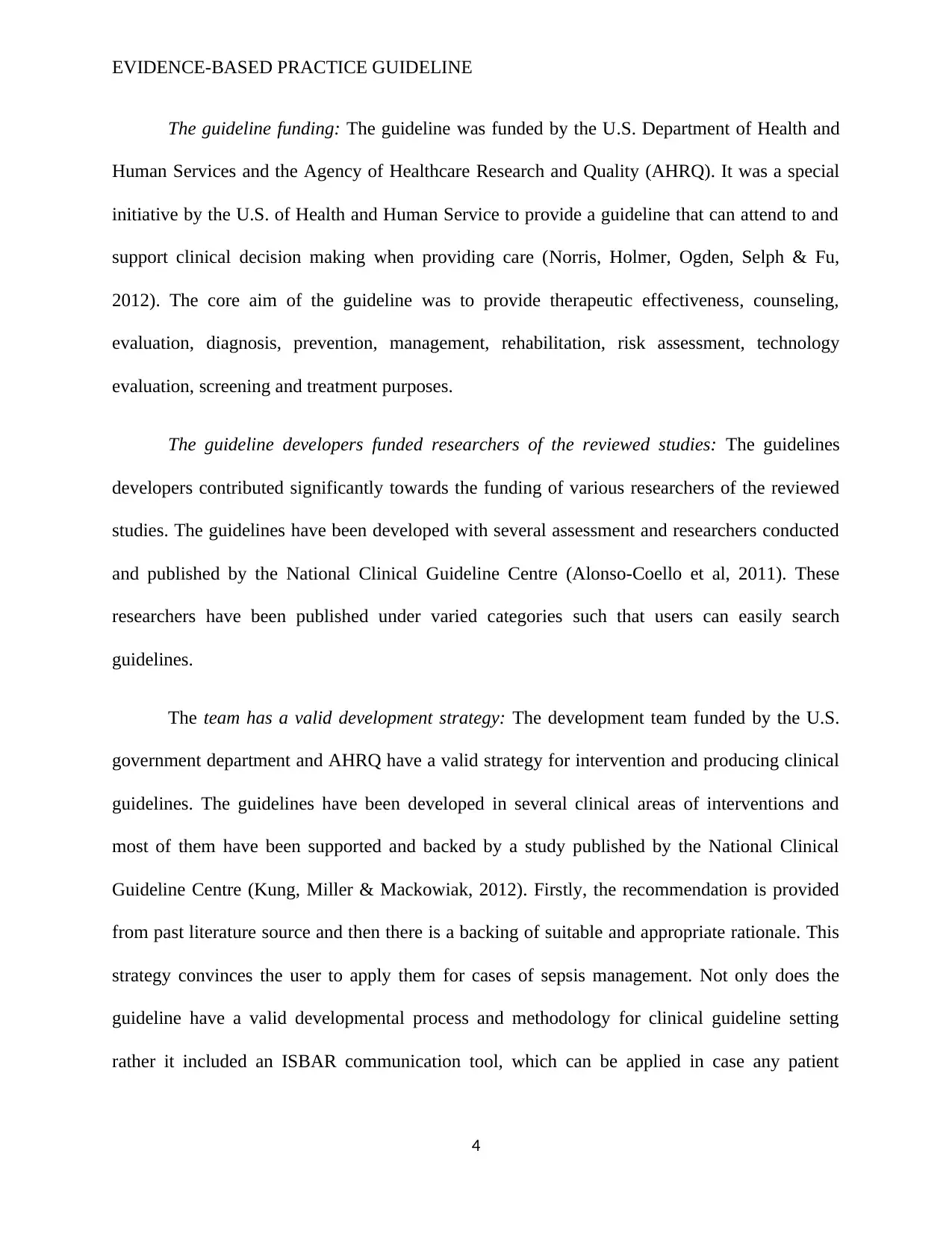
EVIDENCE-BASED PRACTICE GUIDELINE
The guideline funding: The guideline was funded by the U.S. Department of Health and
Human Services and the Agency of Healthcare Research and Quality (AHRQ). It was a special
initiative by the U.S. of Health and Human Service to provide a guideline that can attend to and
support clinical decision making when providing care (Norris, Holmer, Ogden, Selph & Fu,
2012). The core aim of the guideline was to provide therapeutic effectiveness, counseling,
evaluation, diagnosis, prevention, management, rehabilitation, risk assessment, technology
evaluation, screening and treatment purposes.
The guideline developers funded researchers of the reviewed studies: The guidelines
developers contributed significantly towards the funding of various researchers of the reviewed
studies. The guidelines have been developed with several assessment and researchers conducted
and published by the National Clinical Guideline Centre (Alonso-Coello et al, 2011). These
researchers have been published under varied categories such that users can easily search
guidelines.
The team has a valid development strategy: The development team funded by the U.S.
government department and AHRQ have a valid strategy for intervention and producing clinical
guidelines. The guidelines have been developed in several clinical areas of interventions and
most of them have been supported and backed by a study published by the National Clinical
Guideline Centre (Kung, Miller & Mackowiak, 2012). Firstly, the recommendation is provided
from past literature source and then there is a backing of suitable and appropriate rationale. This
strategy convinces the user to apply them for cases of sepsis management. Not only does the
guideline have a valid developmental process and methodology for clinical guideline setting
rather it included an ISBAR communication tool, which can be applied in case any patient
4
The guideline funding: The guideline was funded by the U.S. Department of Health and
Human Services and the Agency of Healthcare Research and Quality (AHRQ). It was a special
initiative by the U.S. of Health and Human Service to provide a guideline that can attend to and
support clinical decision making when providing care (Norris, Holmer, Ogden, Selph & Fu,
2012). The core aim of the guideline was to provide therapeutic effectiveness, counseling,
evaluation, diagnosis, prevention, management, rehabilitation, risk assessment, technology
evaluation, screening and treatment purposes.
The guideline developers funded researchers of the reviewed studies: The guidelines
developers contributed significantly towards the funding of various researchers of the reviewed
studies. The guidelines have been developed with several assessment and researchers conducted
and published by the National Clinical Guideline Centre (Alonso-Coello et al, 2011). These
researchers have been published under varied categories such that users can easily search
guidelines.
The team has a valid development strategy: The development team funded by the U.S.
government department and AHRQ have a valid strategy for intervention and producing clinical
guidelines. The guidelines have been developed in several clinical areas of interventions and
most of them have been supported and backed by a study published by the National Clinical
Guideline Centre (Kung, Miller & Mackowiak, 2012). Firstly, the recommendation is provided
from past literature source and then there is a backing of suitable and appropriate rationale. This
strategy convinces the user to apply them for cases of sepsis management. Not only does the
guideline have a valid developmental process and methodology for clinical guideline setting
rather it included an ISBAR communication tool, which can be applied in case any patient
4
Secure Best Marks with AI Grader
Need help grading? Try our AI Grader for instant feedback on your assignments.
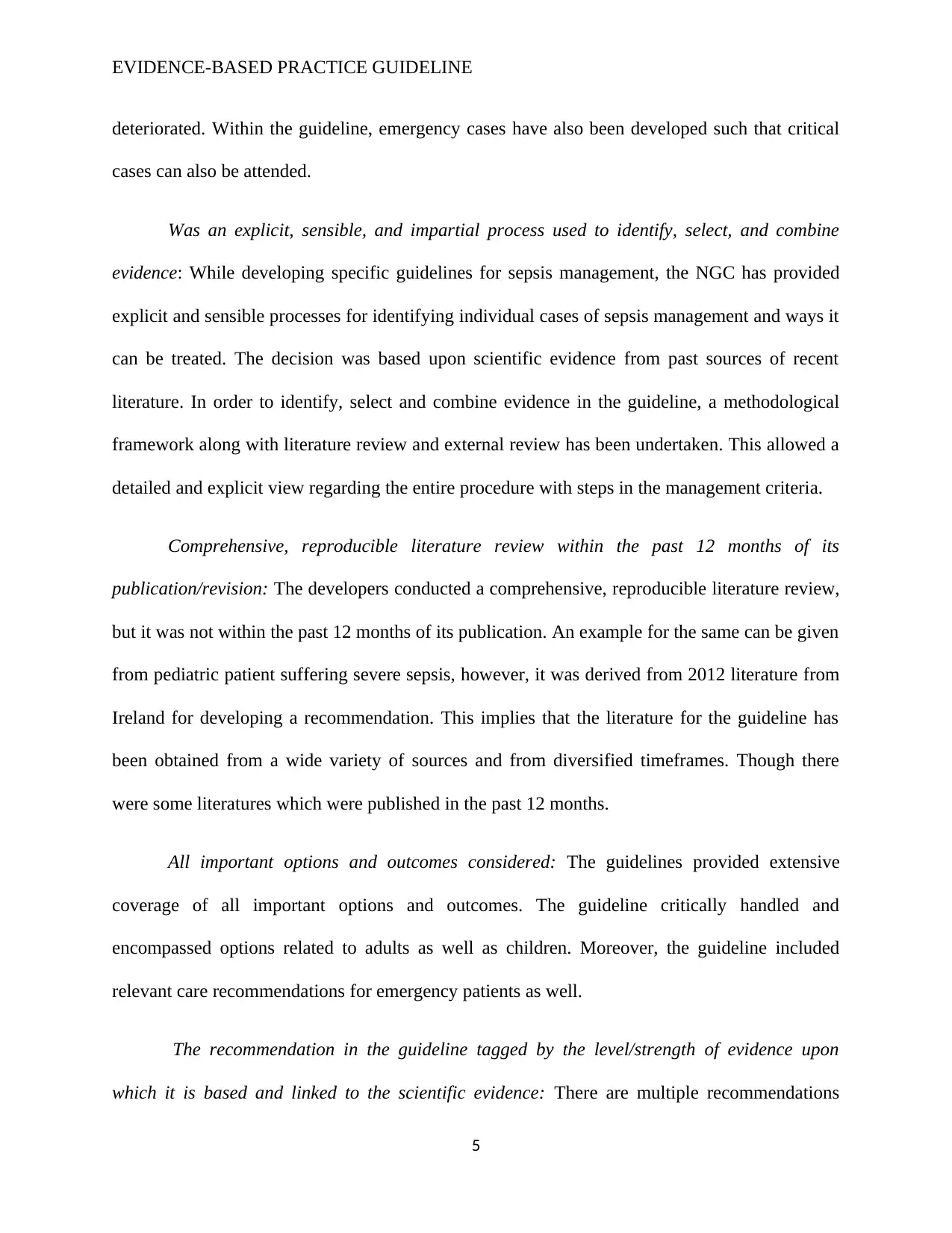
EVIDENCE-BASED PRACTICE GUIDELINE
deteriorated. Within the guideline, emergency cases have also been developed such that critical
cases can also be attended.
Was an explicit, sensible, and impartial process used to identify, select, and combine
evidence: While developing specific guidelines for sepsis management, the NGC has provided
explicit and sensible processes for identifying individual cases of sepsis management and ways it
can be treated. The decision was based upon scientific evidence from past sources of recent
literature. In order to identify, select and combine evidence in the guideline, a methodological
framework along with literature review and external review has been undertaken. This allowed a
detailed and explicit view regarding the entire procedure with steps in the management criteria.
Comprehensive, reproducible literature review within the past 12 months of its
publication/revision: The developers conducted a comprehensive, reproducible literature review,
but it was not within the past 12 months of its publication. An example for the same can be given
from pediatric patient suffering severe sepsis, however, it was derived from 2012 literature from
Ireland for developing a recommendation. This implies that the literature for the guideline has
been obtained from a wide variety of sources and from diversified timeframes. Though there
were some literatures which were published in the past 12 months.
All important options and outcomes considered: The guidelines provided extensive
coverage of all important options and outcomes. The guideline critically handled and
encompassed options related to adults as well as children. Moreover, the guideline included
relevant care recommendations for emergency patients as well.
The recommendation in the guideline tagged by the level/strength of evidence upon
which it is based and linked to the scientific evidence: There are multiple recommendations
5
deteriorated. Within the guideline, emergency cases have also been developed such that critical
cases can also be attended.
Was an explicit, sensible, and impartial process used to identify, select, and combine
evidence: While developing specific guidelines for sepsis management, the NGC has provided
explicit and sensible processes for identifying individual cases of sepsis management and ways it
can be treated. The decision was based upon scientific evidence from past sources of recent
literature. In order to identify, select and combine evidence in the guideline, a methodological
framework along with literature review and external review has been undertaken. This allowed a
detailed and explicit view regarding the entire procedure with steps in the management criteria.
Comprehensive, reproducible literature review within the past 12 months of its
publication/revision: The developers conducted a comprehensive, reproducible literature review,
but it was not within the past 12 months of its publication. An example for the same can be given
from pediatric patient suffering severe sepsis, however, it was derived from 2012 literature from
Ireland for developing a recommendation. This implies that the literature for the guideline has
been obtained from a wide variety of sources and from diversified timeframes. Though there
were some literatures which were published in the past 12 months.
All important options and outcomes considered: The guidelines provided extensive
coverage of all important options and outcomes. The guideline critically handled and
encompassed options related to adults as well as children. Moreover, the guideline included
relevant care recommendations for emergency patients as well.
The recommendation in the guideline tagged by the level/strength of evidence upon
which it is based and linked to the scientific evidence: There are multiple recommendations
5
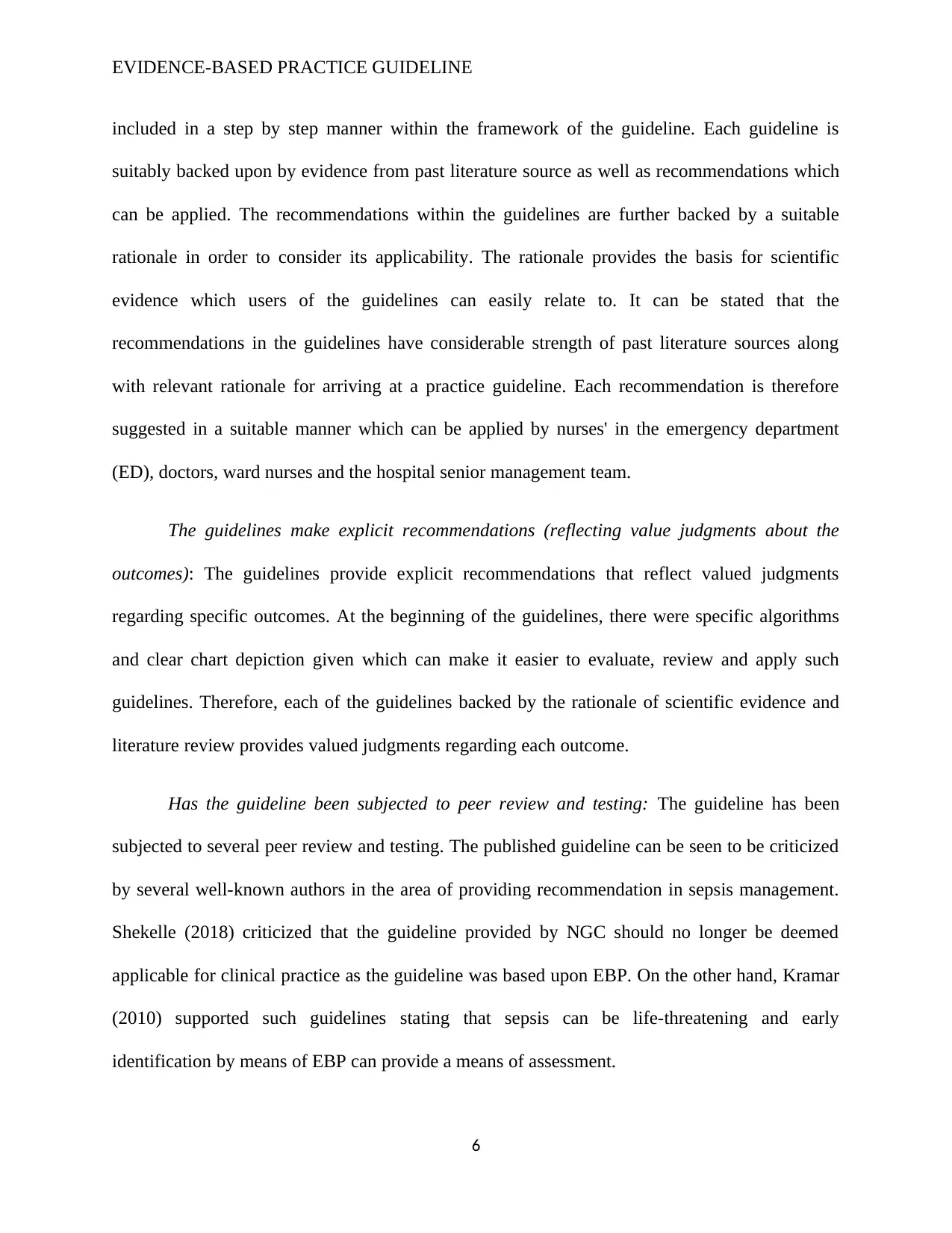
EVIDENCE-BASED PRACTICE GUIDELINE
included in a step by step manner within the framework of the guideline. Each guideline is
suitably backed upon by evidence from past literature source as well as recommendations which
can be applied. The recommendations within the guidelines are further backed by a suitable
rationale in order to consider its applicability. The rationale provides the basis for scientific
evidence which users of the guidelines can easily relate to. It can be stated that the
recommendations in the guidelines have considerable strength of past literature sources along
with relevant rationale for arriving at a practice guideline. Each recommendation is therefore
suggested in a suitable manner which can be applied by nurses' in the emergency department
(ED), doctors, ward nurses and the hospital senior management team.
The guidelines make explicit recommendations (reflecting value judgments about the
outcomes): The guidelines provide explicit recommendations that reflect valued judgments
regarding specific outcomes. At the beginning of the guidelines, there were specific algorithms
and clear chart depiction given which can make it easier to evaluate, review and apply such
guidelines. Therefore, each of the guidelines backed by the rationale of scientific evidence and
literature review provides valued judgments regarding each outcome.
Has the guideline been subjected to peer review and testing: The guideline has been
subjected to several peer review and testing. The published guideline can be seen to be criticized
by several well-known authors in the area of providing recommendation in sepsis management.
Shekelle (2018) criticized that the guideline provided by NGC should no longer be deemed
applicable for clinical practice as the guideline was based upon EBP. On the other hand, Kramar
(2010) supported such guidelines stating that sepsis can be life-threatening and early
identification by means of EBP can provide a means of assessment.
6
included in a step by step manner within the framework of the guideline. Each guideline is
suitably backed upon by evidence from past literature source as well as recommendations which
can be applied. The recommendations within the guidelines are further backed by a suitable
rationale in order to consider its applicability. The rationale provides the basis for scientific
evidence which users of the guidelines can easily relate to. It can be stated that the
recommendations in the guidelines have considerable strength of past literature sources along
with relevant rationale for arriving at a practice guideline. Each recommendation is therefore
suggested in a suitable manner which can be applied by nurses' in the emergency department
(ED), doctors, ward nurses and the hospital senior management team.
The guidelines make explicit recommendations (reflecting value judgments about the
outcomes): The guidelines provide explicit recommendations that reflect valued judgments
regarding specific outcomes. At the beginning of the guidelines, there were specific algorithms
and clear chart depiction given which can make it easier to evaluate, review and apply such
guidelines. Therefore, each of the guidelines backed by the rationale of scientific evidence and
literature review provides valued judgments regarding each outcome.
Has the guideline been subjected to peer review and testing: The guideline has been
subjected to several peer review and testing. The published guideline can be seen to be criticized
by several well-known authors in the area of providing recommendation in sepsis management.
Shekelle (2018) criticized that the guideline provided by NGC should no longer be deemed
applicable for clinical practice as the guideline was based upon EBP. On the other hand, Kramar
(2010) supported such guidelines stating that sepsis can be life-threatening and early
identification by means of EBP can provide a means of assessment.
6
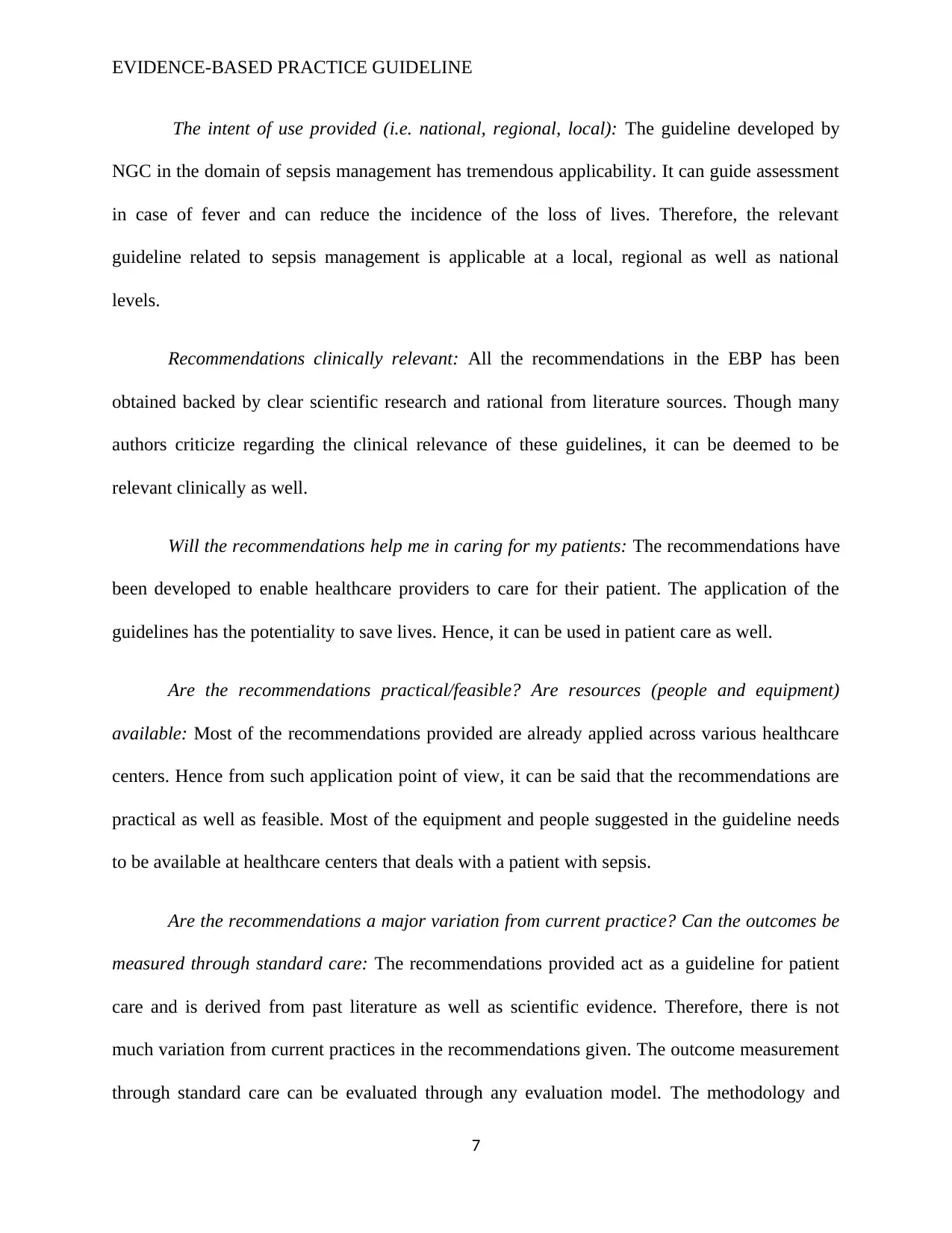
EVIDENCE-BASED PRACTICE GUIDELINE
The intent of use provided (i.e. national, regional, local): The guideline developed by
NGC in the domain of sepsis management has tremendous applicability. It can guide assessment
in case of fever and can reduce the incidence of the loss of lives. Therefore, the relevant
guideline related to sepsis management is applicable at a local, regional as well as national
levels.
Recommendations clinically relevant: All the recommendations in the EBP has been
obtained backed by clear scientific research and rational from literature sources. Though many
authors criticize regarding the clinical relevance of these guidelines, it can be deemed to be
relevant clinically as well.
Will the recommendations help me in caring for my patients: The recommendations have
been developed to enable healthcare providers to care for their patient. The application of the
guidelines has the potentiality to save lives. Hence, it can be used in patient care as well.
Are the recommendations practical/feasible? Are resources (people and equipment)
available: Most of the recommendations provided are already applied across various healthcare
centers. Hence from such application point of view, it can be said that the recommendations are
practical as well as feasible. Most of the equipment and people suggested in the guideline needs
to be available at healthcare centers that deals with a patient with sepsis.
Are the recommendations a major variation from current practice? Can the outcomes be
measured through standard care: The recommendations provided act as a guideline for patient
care and is derived from past literature as well as scientific evidence. Therefore, there is not
much variation from current practices in the recommendations given. The outcome measurement
through standard care can be evaluated through any evaluation model. The methodology and
7
The intent of use provided (i.e. national, regional, local): The guideline developed by
NGC in the domain of sepsis management has tremendous applicability. It can guide assessment
in case of fever and can reduce the incidence of the loss of lives. Therefore, the relevant
guideline related to sepsis management is applicable at a local, regional as well as national
levels.
Recommendations clinically relevant: All the recommendations in the EBP has been
obtained backed by clear scientific research and rational from literature sources. Though many
authors criticize regarding the clinical relevance of these guidelines, it can be deemed to be
relevant clinically as well.
Will the recommendations help me in caring for my patients: The recommendations have
been developed to enable healthcare providers to care for their patient. The application of the
guidelines has the potentiality to save lives. Hence, it can be used in patient care as well.
Are the recommendations practical/feasible? Are resources (people and equipment)
available: Most of the recommendations provided are already applied across various healthcare
centers. Hence from such application point of view, it can be said that the recommendations are
practical as well as feasible. Most of the equipment and people suggested in the guideline needs
to be available at healthcare centers that deals with a patient with sepsis.
Are the recommendations a major variation from current practice? Can the outcomes be
measured through standard care: The recommendations provided act as a guideline for patient
care and is derived from past literature as well as scientific evidence. Therefore, there is not
much variation from current practices in the recommendations given. The outcome measurement
through standard care can be evaluated through any evaluation model. The methodology and
7
Paraphrase This Document
Need a fresh take? Get an instant paraphrase of this document with our AI Paraphraser
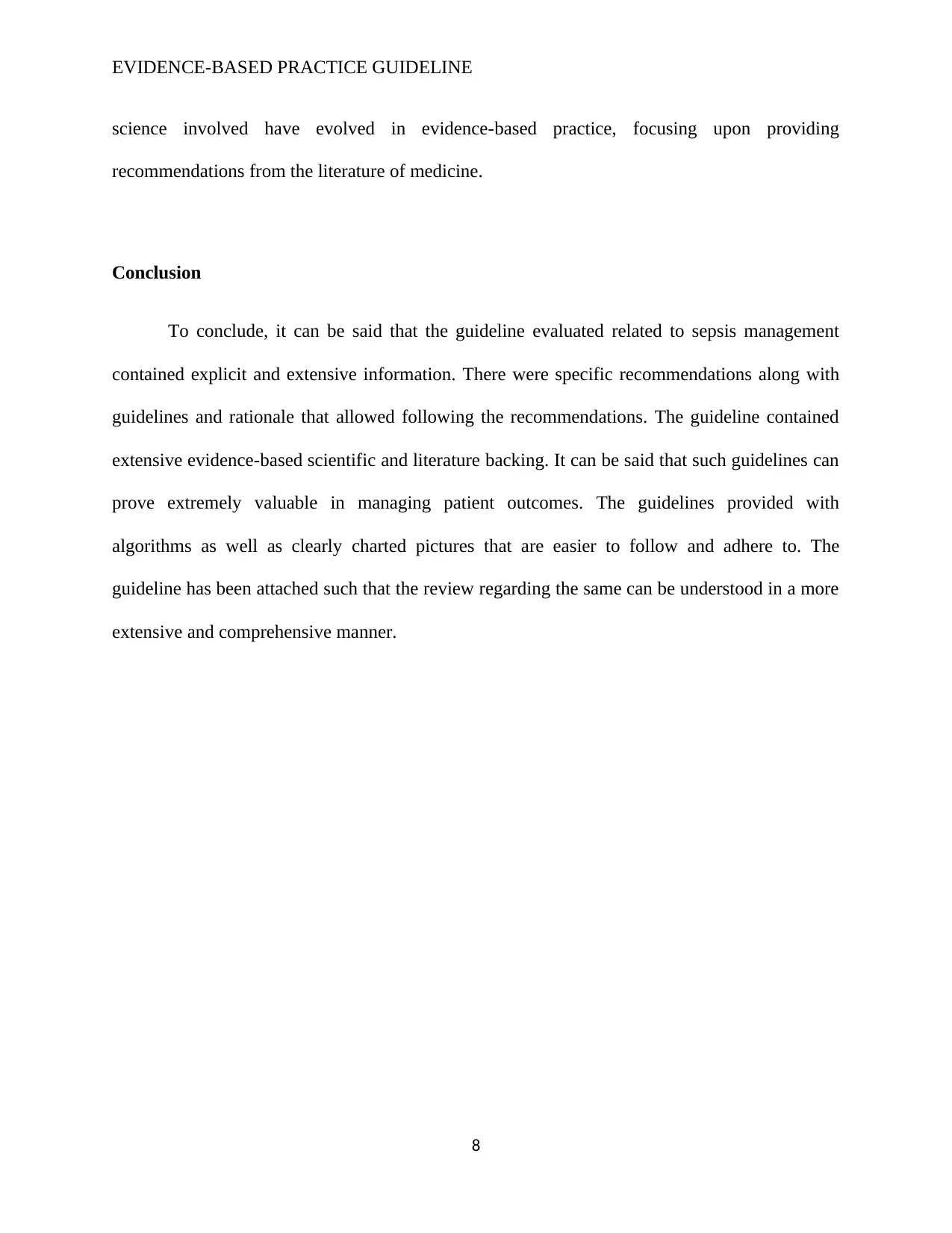
EVIDENCE-BASED PRACTICE GUIDELINE
science involved have evolved in evidence-based practice, focusing upon providing
recommendations from the literature of medicine.
Conclusion
To conclude, it can be said that the guideline evaluated related to sepsis management
contained explicit and extensive information. There were specific recommendations along with
guidelines and rationale that allowed following the recommendations. The guideline contained
extensive evidence-based scientific and literature backing. It can be said that such guidelines can
prove extremely valuable in managing patient outcomes. The guidelines provided with
algorithms as well as clearly charted pictures that are easier to follow and adhere to. The
guideline has been attached such that the review regarding the same can be understood in a more
extensive and comprehensive manner.
8
science involved have evolved in evidence-based practice, focusing upon providing
recommendations from the literature of medicine.
Conclusion
To conclude, it can be said that the guideline evaluated related to sepsis management
contained explicit and extensive information. There were specific recommendations along with
guidelines and rationale that allowed following the recommendations. The guideline contained
extensive evidence-based scientific and literature backing. It can be said that such guidelines can
prove extremely valuable in managing patient outcomes. The guidelines provided with
algorithms as well as clearly charted pictures that are easier to follow and adhere to. The
guideline has been attached such that the review regarding the same can be understood in a more
extensive and comprehensive manner.
8
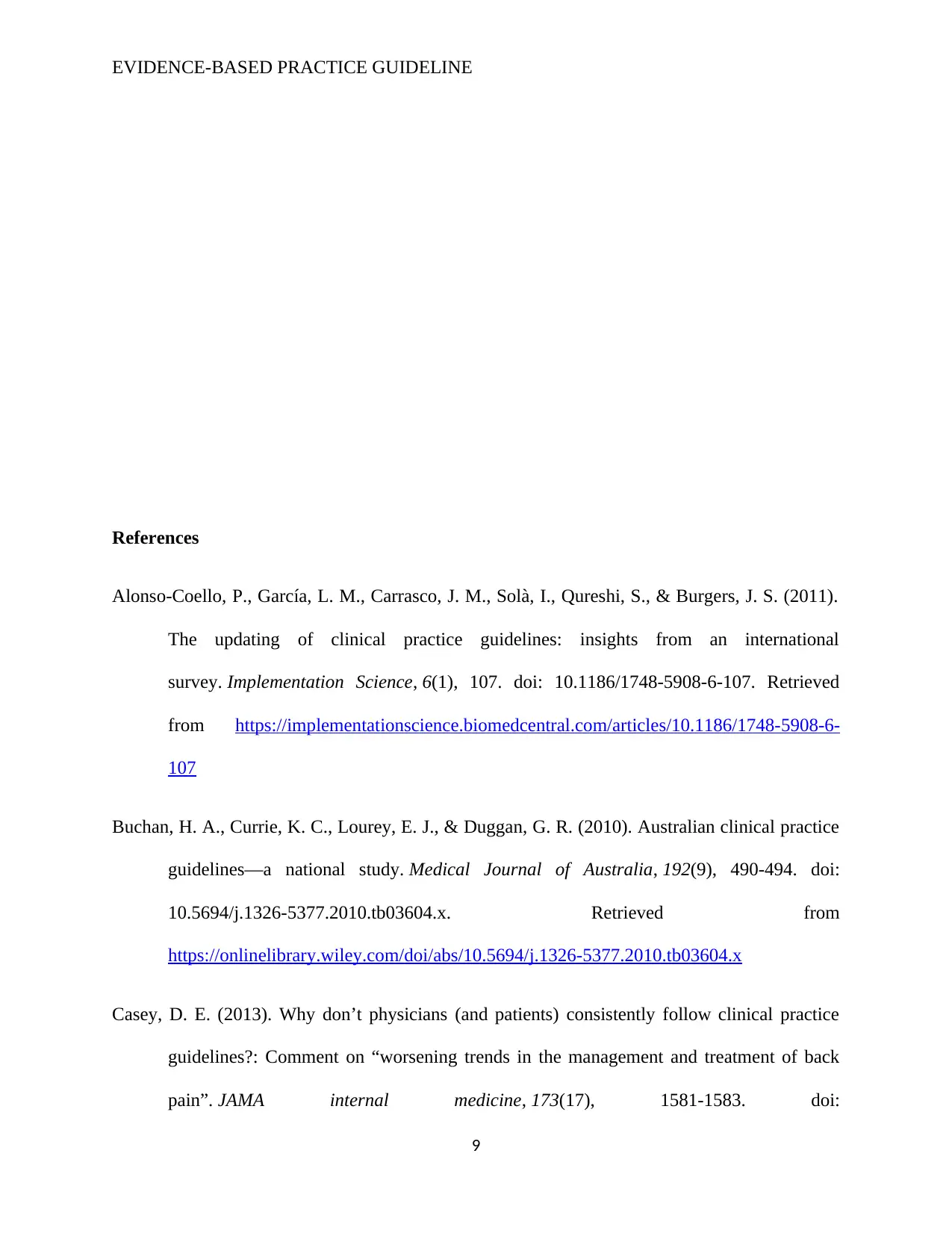
EVIDENCE-BASED PRACTICE GUIDELINE
References
Alonso-Coello, P., García, L. M., Carrasco, J. M., Solà, I., Qureshi, S., & Burgers, J. S. (2011).
The updating of clinical practice guidelines: insights from an international
survey. Implementation Science, 6(1), 107. doi: 10.1186/1748-5908-6-107. Retrieved
from https://implementationscience.biomedcentral.com/articles/10.1186/1748-5908-6-
107
Buchan, H. A., Currie, K. C., Lourey, E. J., & Duggan, G. R. (2010). Australian clinical practice
guidelines—a national study. Medical Journal of Australia, 192(9), 490-494. doi:
10.5694/j.1326-5377.2010.tb03604.x. Retrieved from
https://onlinelibrary.wiley.com/doi/abs/10.5694/j.1326-5377.2010.tb03604.x
Casey, D. E. (2013). Why don’t physicians (and patients) consistently follow clinical practice
guidelines?: Comment on “worsening trends in the management and treatment of back
pain”. JAMA internal medicine, 173(17), 1581-1583. doi:
9
References
Alonso-Coello, P., García, L. M., Carrasco, J. M., Solà, I., Qureshi, S., & Burgers, J. S. (2011).
The updating of clinical practice guidelines: insights from an international
survey. Implementation Science, 6(1), 107. doi: 10.1186/1748-5908-6-107. Retrieved
from https://implementationscience.biomedcentral.com/articles/10.1186/1748-5908-6-
107
Buchan, H. A., Currie, K. C., Lourey, E. J., & Duggan, G. R. (2010). Australian clinical practice
guidelines—a national study. Medical Journal of Australia, 192(9), 490-494. doi:
10.5694/j.1326-5377.2010.tb03604.x. Retrieved from
https://onlinelibrary.wiley.com/doi/abs/10.5694/j.1326-5377.2010.tb03604.x
Casey, D. E. (2013). Why don’t physicians (and patients) consistently follow clinical practice
guidelines?: Comment on “worsening trends in the management and treatment of back
pain”. JAMA internal medicine, 173(17), 1581-1583. doi:
9
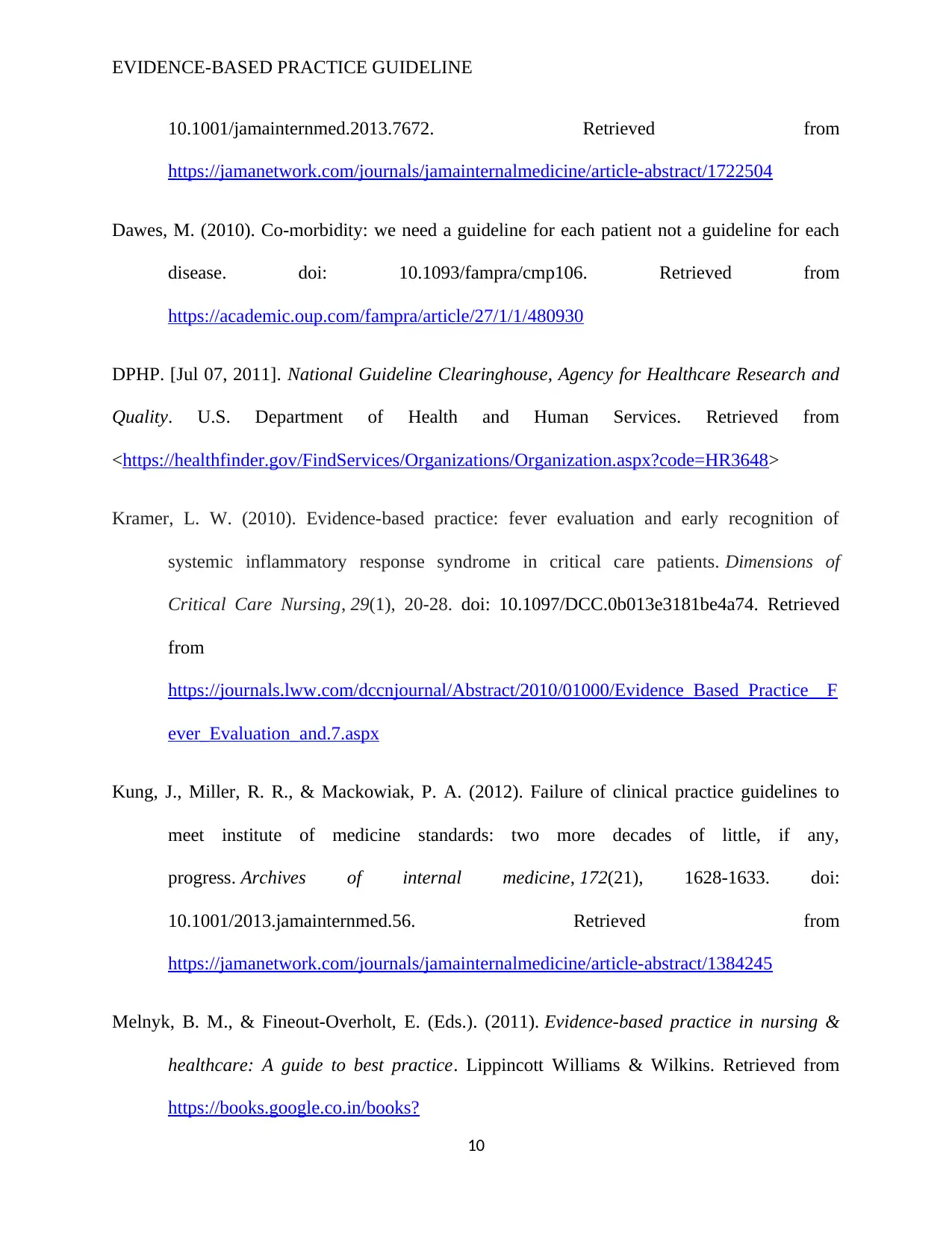
EVIDENCE-BASED PRACTICE GUIDELINE
10.1001/jamainternmed.2013.7672. Retrieved from
https://jamanetwork.com/journals/jamainternalmedicine/article-abstract/1722504
Dawes, M. (2010). Co-morbidity: we need a guideline for each patient not a guideline for each
disease. doi: 10.1093/fampra/cmp106. Retrieved from
https://academic.oup.com/fampra/article/27/1/1/480930
DPHP. [Jul 07, 2011]. National Guideline Clearinghouse, Agency for Healthcare Research and
Quality. U.S. Department of Health and Human Services. Retrieved from
<https://healthfinder.gov/FindServices/Organizations/Organization.aspx?code=HR3648>
Kramer, L. W. (2010). Evidence-based practice: fever evaluation and early recognition of
systemic inflammatory response syndrome in critical care patients. Dimensions of
Critical Care Nursing, 29(1), 20-28. doi: 10.1097/DCC.0b013e3181be4a74. Retrieved
from
https://journals.lww.com/dccnjournal/Abstract/2010/01000/Evidence_Based_Practice__F
ever_Evaluation_and.7.aspx
Kung, J., Miller, R. R., & Mackowiak, P. A. (2012). Failure of clinical practice guidelines to
meet institute of medicine standards: two more decades of little, if any,
progress. Archives of internal medicine, 172(21), 1628-1633. doi:
10.1001/2013.jamainternmed.56. Retrieved from
https://jamanetwork.com/journals/jamainternalmedicine/article-abstract/1384245
Melnyk, B. M., & Fineout-Overholt, E. (Eds.). (2011). Evidence-based practice in nursing &
healthcare: A guide to best practice. Lippincott Williams & Wilkins. Retrieved from
https://books.google.co.in/books?
10
10.1001/jamainternmed.2013.7672. Retrieved from
https://jamanetwork.com/journals/jamainternalmedicine/article-abstract/1722504
Dawes, M. (2010). Co-morbidity: we need a guideline for each patient not a guideline for each
disease. doi: 10.1093/fampra/cmp106. Retrieved from
https://academic.oup.com/fampra/article/27/1/1/480930
DPHP. [Jul 07, 2011]. National Guideline Clearinghouse, Agency for Healthcare Research and
Quality. U.S. Department of Health and Human Services. Retrieved from
<https://healthfinder.gov/FindServices/Organizations/Organization.aspx?code=HR3648>
Kramer, L. W. (2010). Evidence-based practice: fever evaluation and early recognition of
systemic inflammatory response syndrome in critical care patients. Dimensions of
Critical Care Nursing, 29(1), 20-28. doi: 10.1097/DCC.0b013e3181be4a74. Retrieved
from
https://journals.lww.com/dccnjournal/Abstract/2010/01000/Evidence_Based_Practice__F
ever_Evaluation_and.7.aspx
Kung, J., Miller, R. R., & Mackowiak, P. A. (2012). Failure of clinical practice guidelines to
meet institute of medicine standards: two more decades of little, if any,
progress. Archives of internal medicine, 172(21), 1628-1633. doi:
10.1001/2013.jamainternmed.56. Retrieved from
https://jamanetwork.com/journals/jamainternalmedicine/article-abstract/1384245
Melnyk, B. M., & Fineout-Overholt, E. (Eds.). (2011). Evidence-based practice in nursing &
healthcare: A guide to best practice. Lippincott Williams & Wilkins. Retrieved from
https://books.google.co.in/books?
10
Secure Best Marks with AI Grader
Need help grading? Try our AI Grader for instant feedback on your assignments.
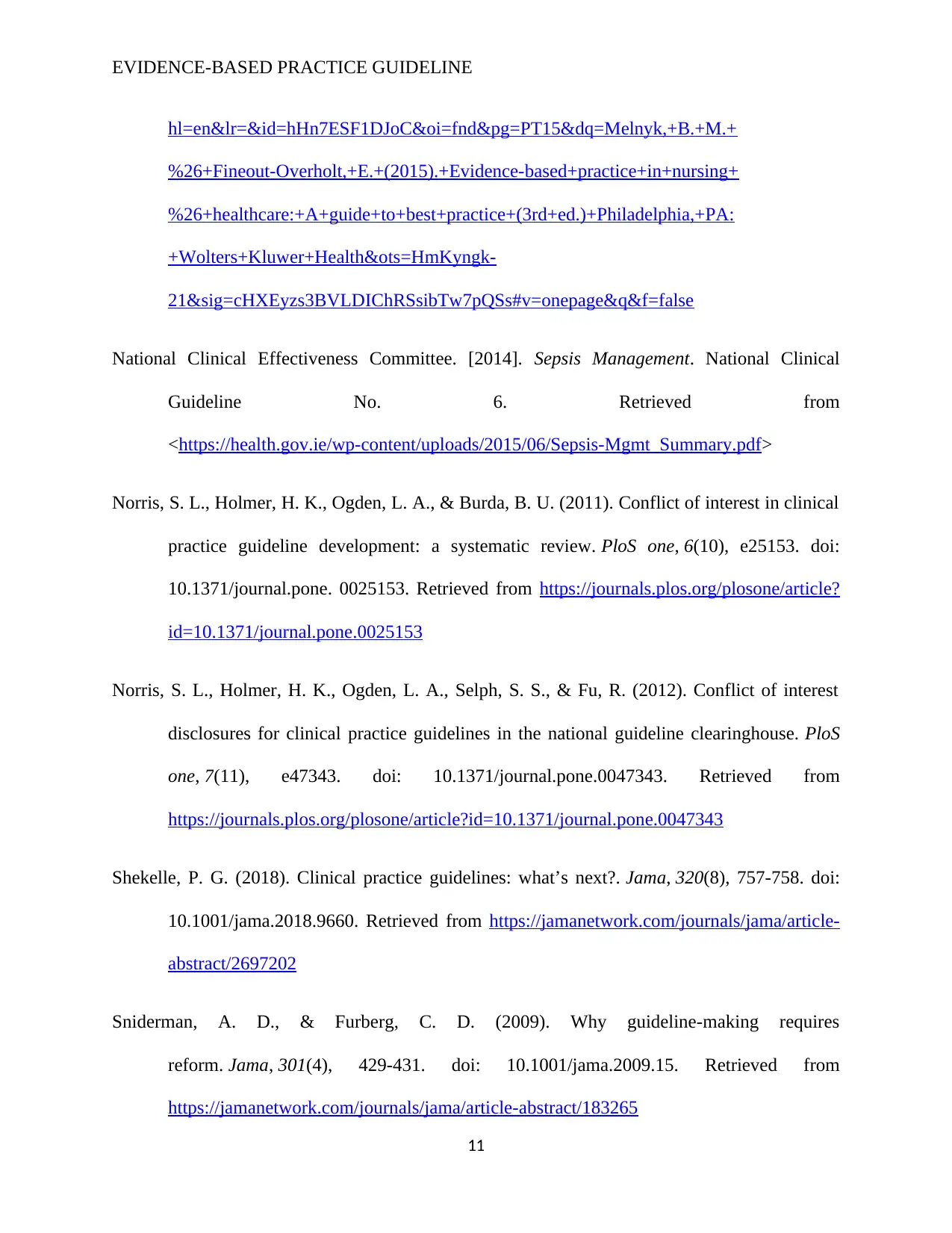
EVIDENCE-BASED PRACTICE GUIDELINE
hl=en&lr=&id=hHn7ESF1DJoC&oi=fnd&pg=PT15&dq=Melnyk,+B.+M.+
%26+Fineout-Overholt,+E.+(2015).+Evidence-based+practice+in+nursing+
%26+healthcare:+A+guide+to+best+practice+(3rd+ed.)+Philadelphia,+PA:
+Wolters+Kluwer+Health&ots=HmKyngk-
21&sig=cHXEyzs3BVLDIChRSsibTw7pQSs#v=onepage&q&f=false
National Clinical Effectiveness Committee. [2014]. Sepsis Management. National Clinical
Guideline No. 6. Retrieved from
<https://health.gov.ie/wp-content/uploads/2015/06/Sepsis-Mgmt_Summary.pdf>
Norris, S. L., Holmer, H. K., Ogden, L. A., & Burda, B. U. (2011). Conflict of interest in clinical
practice guideline development: a systematic review. PloS one, 6(10), e25153. doi:
10.1371/journal.pone. 0025153. Retrieved from https://journals.plos.org/plosone/article?
id=10.1371/journal.pone.0025153
Norris, S. L., Holmer, H. K., Ogden, L. A., Selph, S. S., & Fu, R. (2012). Conflict of interest
disclosures for clinical practice guidelines in the national guideline clearinghouse. PloS
one, 7(11), e47343. doi: 10.1371/journal.pone.0047343. Retrieved from
https://journals.plos.org/plosone/article?id=10.1371/journal.pone.0047343
Shekelle, P. G. (2018). Clinical practice guidelines: what’s next?. Jama, 320(8), 757-758. doi:
10.1001/jama.2018.9660. Retrieved from https://jamanetwork.com/journals/jama/article-
abstract/2697202
Sniderman, A. D., & Furberg, C. D. (2009). Why guideline-making requires
reform. Jama, 301(4), 429-431. doi: 10.1001/jama.2009.15. Retrieved from
https://jamanetwork.com/journals/jama/article-abstract/183265
11
hl=en&lr=&id=hHn7ESF1DJoC&oi=fnd&pg=PT15&dq=Melnyk,+B.+M.+
%26+Fineout-Overholt,+E.+(2015).+Evidence-based+practice+in+nursing+
%26+healthcare:+A+guide+to+best+practice+(3rd+ed.)+Philadelphia,+PA:
+Wolters+Kluwer+Health&ots=HmKyngk-
21&sig=cHXEyzs3BVLDIChRSsibTw7pQSs#v=onepage&q&f=false
National Clinical Effectiveness Committee. [2014]. Sepsis Management. National Clinical
Guideline No. 6. Retrieved from
<https://health.gov.ie/wp-content/uploads/2015/06/Sepsis-Mgmt_Summary.pdf>
Norris, S. L., Holmer, H. K., Ogden, L. A., & Burda, B. U. (2011). Conflict of interest in clinical
practice guideline development: a systematic review. PloS one, 6(10), e25153. doi:
10.1371/journal.pone. 0025153. Retrieved from https://journals.plos.org/plosone/article?
id=10.1371/journal.pone.0025153
Norris, S. L., Holmer, H. K., Ogden, L. A., Selph, S. S., & Fu, R. (2012). Conflict of interest
disclosures for clinical practice guidelines in the national guideline clearinghouse. PloS
one, 7(11), e47343. doi: 10.1371/journal.pone.0047343. Retrieved from
https://journals.plos.org/plosone/article?id=10.1371/journal.pone.0047343
Shekelle, P. G. (2018). Clinical practice guidelines: what’s next?. Jama, 320(8), 757-758. doi:
10.1001/jama.2018.9660. Retrieved from https://jamanetwork.com/journals/jama/article-
abstract/2697202
Sniderman, A. D., & Furberg, C. D. (2009). Why guideline-making requires
reform. Jama, 301(4), 429-431. doi: 10.1001/jama.2009.15. Retrieved from
https://jamanetwork.com/journals/jama/article-abstract/183265
11
1 out of 11
Related Documents
Your All-in-One AI-Powered Toolkit for Academic Success.
+13062052269
info@desklib.com
Available 24*7 on WhatsApp / Email
![[object Object]](/_next/static/media/star-bottom.7253800d.svg)
Unlock your academic potential
© 2024 | Zucol Services PVT LTD | All rights reserved.





